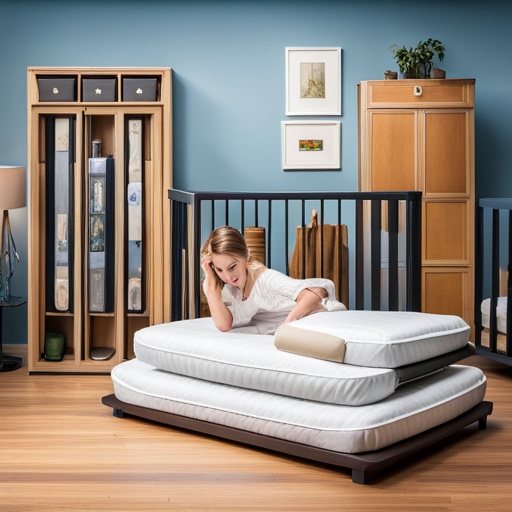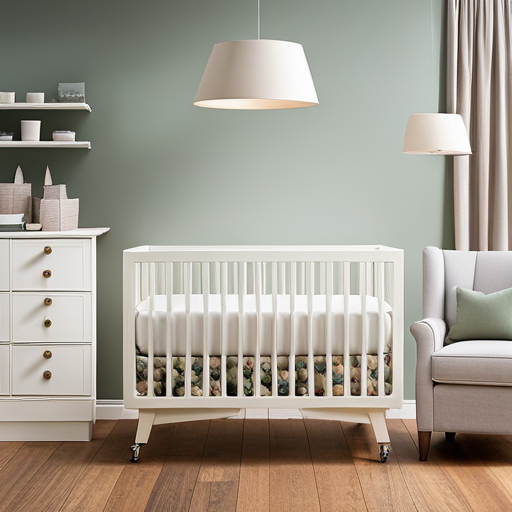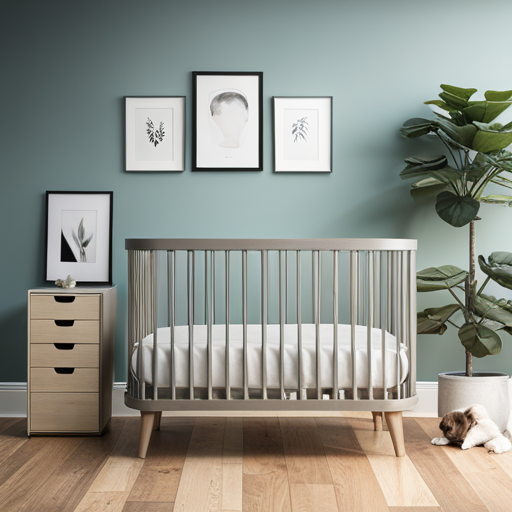"Cherishing Little Steps - A Haven for Baby and Family Journeys"
Baby Sleep in Crib
Did you know that babies spend about 70% of their first year of life sleeping? That’s a lot of precious rest!
As a parent, you want to ensure that your little one is getting the best sleep possible, and one way to do that is by creating a safe and comfortable sleep environment in their crib.
In this guide, we’ll explore everything you need to know about baby sleep in a crib. From choosing the right crib to establishing a consistent bedtime routine, we’ll cover it all.
So get ready to dive into the world of baby sleep and discover the secrets to helping your little one sleep soundly in their crib.
Key Takeaways
- Creating a safe sleep environment reduces the risk of Sudden Infant Death Syndrome (SIDS).
- Safety and comfort should be top priorities when selecting a crib.
- A consistent sleep schedule improves sleep patterns in babies.
- Use sleep aids such as a pacifier or a lovey to provide comfort.
Importance of a Safe Sleep Environment

To ensure your baby’s safety during sleep, it’s crucial to create a secure sleep environment in the crib. Safe sleep practices are essential for reducing the risk of Sudden Infant Death Syndrome (SIDS) and promoting a healthy sleep routine for your little one.
When setting up the crib, make sure to remove any soft bedding, such as pillows, blankets, and stuffed animals. These items can pose a suffocation hazard and increase the risk of SIDS. Instead, use a firm mattress with a fitted sheet specifically designed for cribs.
Position your baby on their back for sleep. This position has been shown to reduce the risk of SIDS. Avoid placing your baby on their side or stomach, as this can increase the chance of suffocation.
Ensure that the crib is free from any potential hazards. Check for loose or broken parts, such as slats or hardware. Make sure the crib meets current safety standards to provide a secure and stable sleep environment for your baby.
Choosing the Right Crib for Your Baby

When selecting a crib for your baby, consider their safety and comfort as top priorities. Ensuring that your baby sleeps in a safe and secure environment is crucial for their well-being. Here are some tips for choosing the right crib for your little one.
Firstly, look for a crib that meets the latest safety standards. Make sure it has a sturdy frame, with slats that are no more than 2 3/8 inches apart, to prevent your baby from getting stuck. Check that the crib doesn’t have any sharp edges or corners that could potentially harm your baby.
Next, consider the mattress. It should fit snugly into the crib, with no gaps that could trap your baby. The mattress should be firm and waterproof, to promote a safe sleeping surface. Avoid fluffy or soft bedding, as it can increase the risk of suffocation.
Additionally, choose a crib that has adjustable mattress heights. As your baby grows and becomes more mobile, you can lower the mattress to prevent them from climbing out. This feature ensures their safety as they develop.
Lastly, consider the overall design and aesthetics of the crib. It should blend well with your nursery and be easy to clean. Look for a crib that’s durable and made from non-toxic materials.
Establishing a Consistent Bedtime Routine

For a successful bedtime routine, start by establishing a consistent schedule that includes soothing activities to help your baby relax and prepare for sleep. Newborns thrive on routine, and having a consistent sleep schedule can greatly improve their sleep patterns. Research shows that babies who have a regular bedtime routine fall asleep faster and stay asleep longer.
To establish a consistent sleep schedule, choose a bedtime that works for both you and your baby. Aim for a time when your baby shows signs of tiredness but isn’t overtired. This will help them settle down more easily. Start with a calming activity, such as a warm bath or gentle massage, to signal to your baby that it’s time to wind down. Follow this with a quiet and dimly lit environment, as this can help promote relaxation.
Incorporate soothing activities into your bedtime routine, such as reading a bedtime story or singing a lullaby. These activities can help create a sense of security and comfort for your baby. Additionally, make sure to create a sleep-friendly environment, with a comfortable crib and the right temperature and lighting.
Creating a Calm and Relaxing Sleep Environment

Ensure your baby’s crib is set up to create a calm and relaxing sleep environment. When it comes to helping your little one sleep peacefully, there are a few key factors to consider.
First, consider using sleep aids such as a pacifier or a lovey. These comfort items can provide a sense of security and help your baby feel more relaxed in their crib.
Additionally, incorporating white noise into your baby’s sleep routine can work wonders. White noise, such as the sound of a fan or a white noise machine, can help drown out any background noises and create a soothing atmosphere for your little one. Research has shown that white noise can be especially effective in helping babies fall asleep faster and stay asleep longer. However, it’s important to ensure that the volume of the white noise isn’t too loud, as this can be harmful to your baby’s hearing.
Introducing Comforting Sleep Associations

To further enhance your baby’s sleep in the crib, introduce comforting sleep associations. These associations can help your baby feel secure and relaxed, making the transition to the crib easier. Here are some comforting sleep aids you can try:
-
A soft and cozy blanket or swaddle: Wrapping your baby in a snug blanket can simulate the feeling of being held, providing comfort and warmth.
-
A favorite stuffed animal: Choose a safe and age-appropriate stuffed animal that your baby can cuddle with. This can become a familiar presence in the crib, promoting feelings of security.
-
White noise machine: Background noise, such as the sound of ocean waves or gentle rain, can soothe your baby and drown out any sudden noises that might disrupt their sleep.
-
A gentle lullaby or calming music: Soft melodies can create a soothing environment and help your baby relax before falling asleep.
-
A nightlight: A dim light in the room can provide a sense of security and help your baby feel more comfortable in the crib.
Dealing With Sleep Regressions and Sleep Training

When dealing with sleep regressions and sleep training, it’s important to establish a consistent bedtime routine. This routine will provide your baby with a sense of security and help them understand that it’s time to sleep.
As you transition from co-sleeping to crib sleeping, separation anxiety may arise. This is completely normal and can be managed with patience and understanding.
During sleep training, it’s important to give your baby the opportunity to learn to self-soothe. This means gradually reducing your presence and involvement in the sleep routine. Start by sitting by the crib and comforting your baby without picking them up. Over time, gradually increase the distance between you and the crib, until your baby can fall asleep independently.
Dealing with separation anxiety during sleep training can be challenging, but it’s important to remain consistent. Your baby needs to learn that they can feel safe and secure in their crib, even when you’re not right beside them. Offer reassurance and comfort during the day, so they feel connected and loved, which will help them feel more secure at night.
Understanding Your Baby’s Sleep Patterns

As you transition your baby from co-sleeping to crib sleeping, it’s important to understand their sleep patterns. By gaining insight into how babies sleep, you can better navigate the challenges of baby sleep training and ensure your little one gets the rest they need. Here are five key points to help you understand your baby’s sleep patterns:
-
Sleep cycles: Babies have shorter sleep cycles than adults, typically lasting around 50-60 minutes. Understanding these cycles can help you anticipate when your baby may wake up and adjust your sleep routine accordingly.
-
REM sleep: Rapid Eye Movement (REM) sleep is a crucial part of your baby’s sleep cycle. During REM sleep, your baby’s brain is highly active, and this is when most dreaming occurs. It’s normal for babies to spend a significant portion of their sleep time in REM sleep.
-
Sleep cues: Babies give off subtle signals when they’re tired and ready to sleep. Pay attention to your baby’s cues, such as rubbing their eyes, yawning, or becoming fussy, to help you determine when it’s time to put them down for a nap or bedtime.
-
Daytime vs. nighttime sleep: Newborns may have their days and nights mixed up initially. Help your baby differentiate between daytime and nighttime sleep by exposing them to natural light during the day and keeping the environment calm and dark at night.
-
Sleep patterns evolve: As your baby grows, their sleep patterns will change. Be prepared for transitions, such as dropping naps or experiencing sleep regressions, and adapt your sleep routine accordingly.
Understanding your baby’s sleep patterns is essential for successful baby sleep training. By recognizing their sleep cycles, being mindful of sleep cues, and adjusting their sleep environment, you can help your baby develop healthy sleep habits and get the rest they need.
Handling Nighttime Wake-ups and Sleep Disruptions

During nighttime wake-ups and sleep disruptions, you can effectively address your baby’s needs by implementing consistent soothing techniques. One common reason for nighttime wake-ups is the need for a feeding. Babies have small tummies and may require frequent nighttime feedings, especially during the first few months. To minimize disruptions, try to establish a feeding routine that aligns with your baby’s natural sleep patterns. This can help them feel satisfied and more likely to sleep through the night.
Another common cause of sleep disruptions is teething. Teething can be uncomfortable and painful for babies, leading to frequent awakenings during the night. To address this, you can provide your baby with teething toys or offer them a cool, damp cloth to chew on before bedtime. Additionally, using a teething gel or medication recommended by your pediatrician may help alleviate the discomfort and promote better sleep.
Consistency is key when handling nighttime wake-ups and sleep disruptions. Establishing a bedtime routine that includes soothing activities like reading a book or singing a lullaby can signal to your baby that it’s time for sleep. When your baby wakes up, try to respond consistently by using the same soothing techniques each time. This can help your baby feel secure and understand that nighttime is for sleeping.
Troubleshooting Common Sleep Issues and Solutions

To troubleshoot common sleep issues and find solutions, you can address specific challenges that may arise during your baby’s sleep in the crib. Sleep regressions are a common issue that many parents face. These regressions can happen around 4 months, 8-10 months, and 18 months, and they can disrupt your baby’s sleep patterns. During these times, it’s important to provide extra comfort and reassurance to help your baby adjust to the changes.
Managing sleep disruptions during teething is another challenge you may encounter. Teething can cause discomfort and pain, making it difficult for your baby to fall asleep and stay asleep. To manage this, you can try using teething toys or providing gentle massages to help alleviate your baby’s discomfort.
Other common sleep issues may include difficulty falling asleep, frequent night awakenings, and short naps. To address these problems, you can establish a consistent bedtime routine, create a calm sleep environment, and ensure that your baby is well-rested during the day. Additionally, implementing age-appropriate sleep schedules can help regulate your baby’s sleep patterns.
Frequently Asked Questions
How Can I Help My Baby Transition From Co-Sleeping to Sleeping in a Crib?
To help your baby transition from co-sleeping to sleeping in a crib, try these tips: create a soothing bedtime routine, gradually introduce the crib, use a familiar blanket or toy, provide a comforting environment. Crib sleeping offers benefits like safety and independence.
What Should I Do if My Baby Refuses to Sleep in a Crib?
If your baby refuses to sleep in a crib, don’t panic. It’s common for little ones to resist change. Try helping them adjust by gradually introducing the crib, using alternative sleep arrangements, and offering comfort and reassurance.
How Can I Prevent My Baby From Rolling Over and Getting Stuck in the Crib Bars?
To prevent your baby from rolling over and getting stuck in the crib bars, ensure crib safety by using a properly fitted mattress, removing loose bedding, and keeping the crib free of obstacles.
Are There Any Specific Safety Guidelines I Should Follow When Using a Crib for My Baby’s Sleep?
To ensure a safe sleeping environment for your baby, use a firm crib mattress that fits snugly. Place the crib away from windows, cords, and any hazards. Remember, a comfortable and secure crib is essential for your little one.
How Can I Encourage My Baby to Self-Soothe and Fall Asleep Independently in the Crib?
To encourage your baby to self-soothe and fall asleep independently in the crib, establish a consistent bedtime routine that includes soothing activities like reading or singing. Gradually transition from rocking or holding to placing your baby in the crib while drowsy but awake. Be patient and offer reassurance as they learn this new skill.
Conclusion
In conclusion, creating a safe and comfortable sleep environment is crucial for your baby’s well-being.
Did you know that according to a study conducted by the American Academy of Pediatrics, around 3,500 infants die each year in the United States due to sleep-related causes?
By following the tips and guidelines mentioned in this article, you can help reduce the risk of sleep-related accidents and promote healthy sleep habits for your little one.
Remember, a well-rested baby is a happy baby!



يتجلى التزام المصنع بالاستدامة البيئية من خلال استخدام مواد صديقة للبيئة وممارسات التصنيع الموفرة للطاقة. إيليت بايب Elite Pipe
I do agree with all the ideas you have introduced on your post. They are very convincing and will definitely work. Still, the posts are very short for newbies. May just you please prolong them a little from subsequent time? Thank you for the post.
Incredible, blog yang fantastis! 🌟 Saya sangat kagum dengan kontennya yang edukatif dan mencerahkan. Setiap artikel memberikan informasi segar dan segar. 🚀 Saya benar-benar menikmati membaca setiap kata. Semangat terus! 👏 Sudah tidak sabar untuk membaca konten mendatang. 📚 Terima kasih atas dedikasi dalam memberikan informasi yang bermanfaat dan memberikan inspirasi. 💡🌈 Teruskan pekerjaan yang bagus!
nice content!nice history!! boba 😀
nice content!nice history!! boba 😀
Your publication was like a burst of sunshine, brightening my routine. Keep radiating positivity! 🌞
Your post is a ray of light in the darkness. Thank you for brightening my day in a unique way. Keep shining! ☀️
Keren sekali! 💫 Apakah penulis dari blog ini menerima bayaran? Saya tertarik untuk bergabung!
Luar biasa sekali! 👌 Apakah penulisnya dibayar? Saya tertarik untuk bergabung!